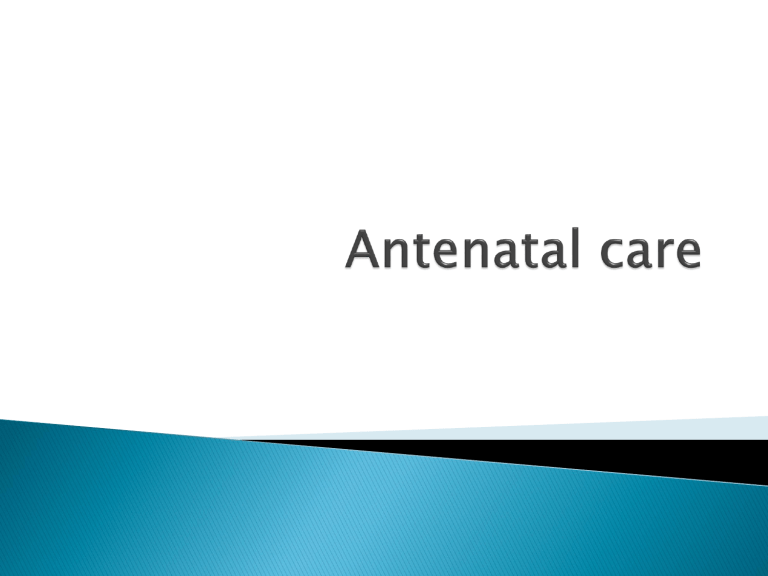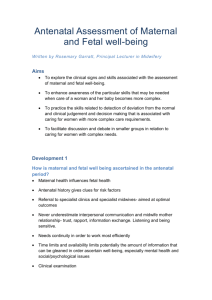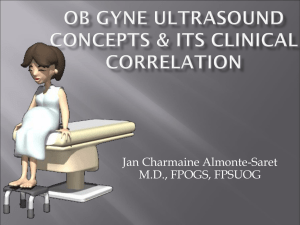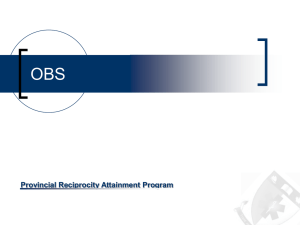Antenatal care

References
-Book of Readings. Nursing Practice 2015 .
-Ladewig, P., London, M., Olds, S.(2012) Maternal
Newborn Nursing Care. Forth Edition. Addison
Wesley.
-Papalia, D.E., & Feldman, R.D. (2013) Human
Development.
12 th Edition, McGraw Hill. New York.
Antenatal care
The systematic supervision of women during pregnancy.
Aims:
1.Promote and maintain maternal and fetal health and welfare.
http://officeimg.vo.msecnd.net/enus/images/MH900047938.jpg
2. Detect early and treat problems that occur.
3. Prepare the woman and her family for the labour, delivery and care of the baby.
Achieved by:
1. Education of mother and family regarding pregnancy, labour and care of the baby.
2. Social and psychological support- to own optimal wellness
3. Regular attendance for ongoing antenatal assessment and appropriate actions to problems that arise.
Lead Maternity Caregiver (LMC)
-Takes responsibility for the care of the woman during her pregnancy, labour, delivery and postnatal period.
(independent midwife, GP, obstetrician, group
Midwives, team based at hospital)
The LMC role includes:
-
-
antenatal care during the pregnancy
Support during labour and the birth of the baby (midwife) postnatal care from the baby’s birth until
4-6 weeks after the birth.
- refers to Well Child provider.
Antenatal History
A thorough antenatal history is taken in an attempt to identify all existing factors which may compromise a healthy mother and baby.
These include:
-medical
-surgical,
-family,
-gynaecological,
-past obstetric, present obstetric
Frequency of visits.
-4 weekly until 28 weeks gestation
-2 weekly until 36 weeks gestation weekly until the birth of the baby.
Routine assessments include:
1. Maternal status / wellbeing
-general health (physical and emotional)
-blood pressure
-weight
-urinalysis (? protein-glucose- ketones)
Why are these tests important?
2. Fetal status / wellbeing
- abdominal examination (size, shape indicates gestation of the pregnancy)
-kick chart / fetal movement chart
-fetal heart rate.
Abdominal examination.
The height of the abdomen indicates fetal growth
Assessing the position of the fetus
General assessments include
-the date of quickening
-braxton-Hicks contractions
-diagnostic tests ( haemoglobin, STDs
Rh status)
Fetal movement chart / Kick Chart
non-invasive assessment of fetal well being carried out by the mother.
Mother notes on the chart the time when she has felt 10 kicks each day (she starts counting at the same time each day eg
0700 hours).
-a pattern will emerge over a few days.
If the pattern changes to very few or no kicks late in the day contact her LMC
Supine Hypotension
When a pregnant woman lies on her back , the weight of the growing uterus presses the vena cava against the verebrae, obstructing blood flow from the lower extremities.
Supine hypotension
-causes decreased blood return from the heart and consequently decreased cardiac output and hypotension
-woman feels light headed and nauseous, may produce less blood flow to the placenta.
ROLL her onto her side
AVOID letting pregnant woman lie flat on their backs
A pregnant woman should contact her doctor with any of the following:
-vaginal bleeding
-premature labour
-rupture of the membranes
-decreased fetal movements
-severe headaches, visual blurring or
“spotting of vision”, swelling explain why?
Prenatal Testing
For various reasons some pregnant women maybe offered prenatal testing. http://www.womenshealthkey.com/wpcontent/uploads/2010/09/prenatal-testing.jpg
Reasons include:
-maternal age
-indicators from previous pregnancy
-previous child with a congenital abnormality
-family history of known conditions
-mother’s medical history
-unknown dates
-assess fetal wellbeing
Maternal serum screening test
-estimates risk of having a child with a chromosomal abnormality
-performed between 15 and 17 weeks gestation.
Ultrasound
-using an ultrasound fetal wellbeing can be observed:
-through assessing growth, size and length of bones and skull a close estimate of the gestation can be made.
-fetal organs
-fetal movements
-the position of the placenta
Fetal Nuchal Translucency Test (NT)
screening to detect chromosomal abnormality.
A scan at 11-14 weeks measures the size of the collection of fluid under the skin behind the fetal neck.
Provides a risk estimate or probability of an abnormality.
Normally is less than 2.5 mm
Chorionic villus sampling (CVS) between (11-12 weeks ) tissue is taken from the developing placenta
-amniocentesis: 15 -16 weeks
An ultrasound guides, a needle into the uterus through the abdomen
-both tests take fluid or tissue directly.
Chromosomal analysis is available from the tissue.
Results are available 2-3 weeks later.
Both procedures carry the risk of miscarriage (up to 1%)
Childbirth education classes
-available from: -maternity hospital
-private childbirth educators
-independent midwives
-Parent Centre, Homebirth
Association
-Marae based classes
Benefits from attending antenatal classes include:
-
-
-
-
-learn about the labour and birth process
-learn and prepare coping strategies for labour
-meet other families
Antenatal care : key points
1.Promote and maintain maternal and fetal health and welfare.
2. Detect early and treat problems that occur.
3. Prepare the woman and her family for the labour, delivery and care of the baby.











